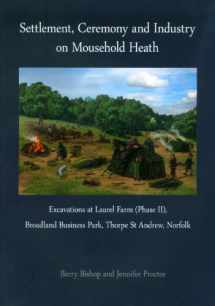
Settlement, Ceremony and Industry on Mousehold Heath: Excavations at Laurel Farm (Phase II), Broadland Business Park, Thorpe St Andrew, Norfolk (Pre-Construct Archaeology Monograph)
ISBN-13:
9780956305442
ISBN-10:
095630544X
Author:
Jennifer Proctor, Victoria Ridgeway, Barry Bishop
Publication date:
2011
Publisher:
Pre-Construct Archaeology
Format:
Paperback
170 pages
FREE US shipping
Book details
ISBN-13:
9780956305442
ISBN-10:
095630544X
Author:
Jennifer Proctor, Victoria Ridgeway, Barry Bishop
Publication date:
2011
Publisher:
Pre-Construct Archaeology
Format:
Paperback
170 pages
Summary
Settlement, Ceremony and Industry on Mousehold Heath: Excavations at Laurel Farm (Phase II), Broadland Business Park, Thorpe St Andrew, Norfolk (Pre-Construct Archaeology Monograph) (ISBN-13: 9780956305442 and ISBN-10: 095630544X), written by authors
Jennifer Proctor, Victoria Ridgeway, Barry Bishop, was published by Pre-Construct Archaeology in 2011.
With an overall rating of 4.5 stars, it's a notable title among other
books. You can easily purchase or rent Settlement, Ceremony and Industry on Mousehold Heath: Excavations at Laurel Farm (Phase II), Broadland Business Park, Thorpe St Andrew, Norfolk (Pre-Construct Archaeology Monograph) (Paperback) from BooksRun,
along with many other new and used
books
and textbooks.
And, if you're looking to sell your copy, our current buyback offer is $0.12.
Description
This publication presents the results of archaeological investigations by Pre-Construct Archaeology at Laurel Farm to the south-east of Norfolk. An extraordinarily long and complex history of occupation and exploitation was revealed, dating back to the Lower Palaeolithic. The site was also visited in the Upper Palaeolithic by hunter-gatherer communities who used the shelter provided by the roots of an upturned tree to knap flint into blades and tools. Tree-throw hollows continued to be significant features in the landscape and, in the Early Neolithic, a remarkable deposit of pottery and flint was placed into a pair of adjacent hollows . Around 4,500 years ago, use of the area changed with the construction of a substantial ring-ditch, probably the remains of a ploughed-out round barrow. From the late Anglo-Saxon into the early Medieval period the area was used for the early stages of iron extraction and production - processes which have rarely been identified archaeologically. There is evidence that ore was quarried, washed and roasted to remove impurities. Mousehold Heath continued to be visited for its natural resources, with gravel quarries and brick kilns exploiting the natural clays, until pressures on agricultural production towards the end of the eighteenth century resulted in the enclosure of the landscape.Table of ContentsChapter 1: Background to the project 1.1 Site description and setting 1.2 Archaeological and historical background 1.3 Methodologies 1.4 Report structure Chapter 2: Phase 1 Natural deposits and Phase 2 Palaeolithic activity 2.1 The natural and Palaeolithic sequence 2.2 Late Glacial/early Post-glacial flintwork Chapter 3: Phase 3 Early Neolithic Activity 3.1 The Early Neolithic archaeological sequence 3.2 Early Neolithic flintwork 3.3 Early Neolithic pottery 3.4 Early Neolithic archaeobotanical analysis Chapter 4: Phase 4 Later Neolithic to Early Bronze Age activity 4.1 The Late Neolithic to Early Bronze Age sequence 4.2 Late Neolithic to Early Bronze Age flintwork 4.3 Late Neolithic to Early Bronze Age pottery 4.4 Stone Identification Chapter 5: Phase 5 Middle to Late Bronze Age activity 5.1 The Middle to Late Bronze Age archaeological sequence 5.2 Middle to Late Bronze Age flintwork 5.3 Middle to Late Bronze Age pottery 5.4 Stone identification 5.5 Analysis of Middle Bronze Age archaeobotanical remains Chapter 6: Phase 6 Middle to Late Iron Age activity 6.1 The Iron Age archaeological sequence 6.2 Iron Age pottery 6.3 Ironworking slag 6.4 Analysis of Iron Age archaeobotanical remains Chapter 7: Phase 7 Roman activity 7.1 The Roman archaeological sequence 7.2 Romano-British pottery 7.3 Romano-British small finds 7.4 Ironworking slag Chapter 8: Phase 8 Anglo-Saxon and early Medieval activity 8.1 The Anglo-Saxon archaeological sequence 8.2 Anglo-Saxon and early Medieval ironworking 8.3 Ironworking slag and industrial residues 8.4 Ironstone 8.5 Saxon pottery 8.6 Analysis of Anglo-Saxon and early Medieval archaeobotanical remains Chapter 9: Phase 9 Later Medieval and Post-Medieval activity 9.1 The later Medieval and Post-Medieval sequence 9.2 Medieval and Post-Medieval pottery 9.3 Medieval and Post-Medieval ceramic building material 9.4 Post-Medieval metal small finds 9.5 Clay tobacco pipe and glass Chapter 10: Discussion 10.1 Phase 2 Palaeolithic flintworking 10.2 Phase 3 Early Neolithic habitation 10.3 Phase 4 Late Neolithic to Early Bronze Age ceremonial activity 10.4 Phase 5 Middle to Late Bronze Age ceremonial activity 10.5 Phase 6 Iron Age farmstead settlement 10.6 Phase 7 Romano-British activity 10.7 Phase 8 Anglo-Saxon and Medieval iron processing 10.8 Phase 9 Mousehold Heath in the later Medieval and Post-Medieval periods Specialist appendices Appendix 1: Radiocarbon dating Appendix 2: Quantification of charred remains Appendix 3: Quantification of ironworking slag


We would LOVE it if you could help us and other readers by reviewing the book
Book review

Congratulations! We have received your book review.
{user}
{createdAt}
by {truncated_author}


